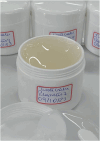Developing a cosmetic formulation containing lipase produced by the fungus Aspergillus terreus
- PMID: 40334180
- PMCID: PMC12058140
- DOI: 10.1371/journal.pone.0322106
Developing a cosmetic formulation containing lipase produced by the fungus Aspergillus terreus
Abstract
This study aimed to evaluate the potential of lipase from Aspergillus terreus as an active ingredient in cosmetic formulations. Lipase was produced using the fungus Aspergillus terreus and was immobilized on gel silica as support. The enzymes were characterized using Scanning Electron Microscopy (SEM), Fourier Transform Infrared Spectroscopy (FTIR), X-ray Diffraction (XRD), Thermogravimetry and Differential Scanning Calorimetry (TG/DSC), and safety evaluation through cytotoxicity tests using NIH-3T3 fibroblast cells. A central composite rotatable design was employed to find the best conditions for enzymatic cosmetic production. The enzyme produced by A. terreus showed activity of 375.9 U/g of substrate, and the immobilized enzyme showed 12.78 U/g of silica, while the lipase from R. oryzae showed activity of 69.91 U/g. As confirmed by FTIR and XRD, SEM showed weak enzyme interaction with silica during immobilization. Cytotoxicity tests showed that only the lipase produced by A. terreus was safe for NIH-3T3 fibroblast cells. The central composite rotatable design showed the agitation time influenced the enzyme activity response. According to the results, the enzyme produced by the fungus A. terreus is a promising and safe product for research into developing new cosmetic products.
Copyright: © 2025 Ramos et al. This is an open access article distributed under the terms of the Creative Commons Attribution License, which permits unrestricted use, distribution, and reproduction in any medium, provided the original author and source are credited.
Conflict of interest statement
The authors have declared that no competing interests exist.
Figures










Similar articles
-
Protic ionic liquid as additive on lipase immobilization using silica sol-gel.Enzyme Microb Technol. 2013 Mar 5;52(3):141-50. doi: 10.1016/j.enzmictec.2012.12.007. Epub 2012 Dec 31. Enzyme Microb Technol. 2013. PMID: 23410924
-
Immobilization of Candida rugosa lipase on poly(3-hydroxybutyrate-co-hydroxyvalerate): a new eco-friendly support.J Ind Microbiol Biotechnol. 2012 Feb;39(2):289-98. doi: 10.1007/s10295-011-1027-3. Epub 2011 Aug 26. J Ind Microbiol Biotechnol. 2012. PMID: 21870100
-
Immobilization of Aspergillus terreus lipase in self-assembled hollow nanospheres for enantioselective hydrolysis of ketoprofen vinyl ester.J Biotechnol. 2015 Jan 20;194:12-8. doi: 10.1016/j.jbiotec.2014.11.032. Epub 2014 Dec 5. J Biotechnol. 2015. PMID: 25483320
-
Immobilization of Lipase by Ionic Liquid-Modified Mesoporous SiO2 Adsorption and Calcium Alginate-Embedding Method.Appl Biochem Biotechnol. 2018 Jul;185(3):606-618. doi: 10.1007/s12010-017-2676-0. Epub 2017 Dec 16. Appl Biochem Biotechnol. 2018. PMID: 29249081
-
Entrapment of surfactant modified lipase within zeolitic imidazolate framework (ZIF)-8.Int J Biol Macromol. 2020 Mar 1;146:678-686. doi: 10.1016/j.ijbiomac.2019.12.164. Epub 2019 Dec 21. Int J Biol Macromol. 2020. PMID: 31870874
References
-
- Guzmán E, Lucia A. Essential oils and their individual components in cosmetic products. Cosmetics. 2021;8(4):114. doi: 10.3390/cosmetics8040114 - DOI
-
- Morone J, Alfeus A, Vasconcelos V, Martins R. Revealing the potential of cyanobacteria in cosmetics and cosmeceuticals — A new bioactive approach. Algal Res. 2019;41:101541. doi: 10.1016/j.algal.2019.101541 - DOI
-
- Ferraz JL de AA, Souza LO, Silva TP, Franco M. Obtenção de lipases microbianas: uma breve revisão. Rev Cienc Exatas Nat. 2018;20(1). doi: 10.5935/recen.2018.01.03 - DOI
-
- Mehta A, Guleria S, Sharma R, Gupta R. The lipases and their applications with emphasis on food industry. Elsevier Inc; 2020. doi: 10.1016/B978-0-12-819813-1.00006-2 - DOI
MeSH terms
Substances
Supplementary concepts
LinkOut - more resources
Full Text Sources
Medical
Research Materials
Miscellaneous

